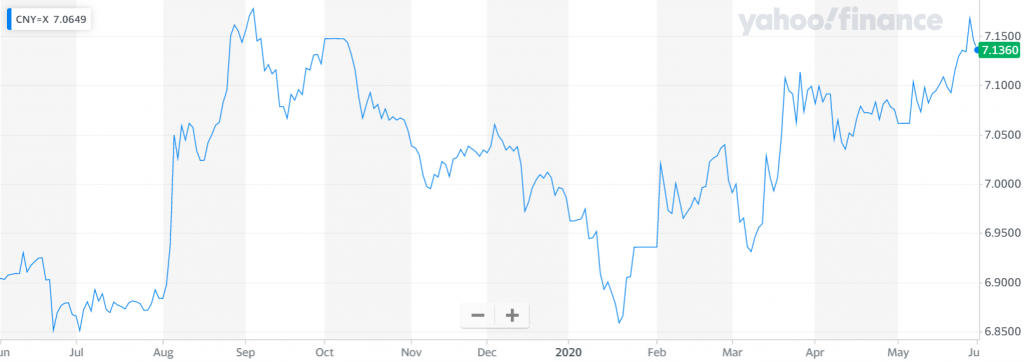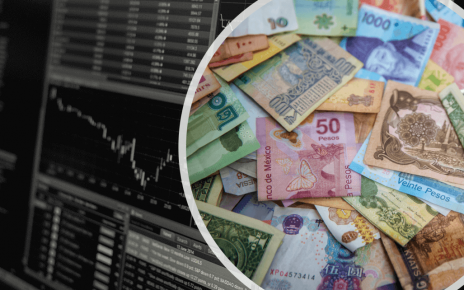Chinese Yuan continues to weaken as tensions between the US and China continue to rise over the Coronavirus crisis. The Chinese Yuan falls to its greatest low on Thursday since the Coronavirus pandemic began in September 2019. The fall in the value of CNY is potentially going to continue due to the US-China uncertain relations.

Source: Chinamoney
Because of this, we are revising our previous USD/CNY forecast to 7.20 within the next quarter and 7.10 within the next four quarters. This is because of the outlook for its short-term bullish movement.
The United States and the USD
There are growing concerns over US-China relations in recent times because of the speechmaking about China’s poor management of the Covid-19 crisis. The US government is planning to issue more financial sanctions and additional tech-restrictions on China while China plans to enforce in Hong Kong a nationwide security regulation.
The ongoing escalating tensions are pushing the price of the Chinese yuan (CNY) down. Our projection is that the tensions will continue to grow in the near-term and into the future as the US election time approaches. The Chinese National People’s Congress sanctioned Hong Kong’s national security law on Thursday resulting in concerns about the disciplinary action taken by the US, which could lead to China reacting negatively.
As the concern about the US-China relations continues to grow, the CNY will potentially continue to get weaker. The long term effect of the tension irrespective of the outcome of the US election, the anti-China talk will continue to grow in the US because the reaction among the American people is more of bipartisanship. Such a view has the potential to continue to escalate the US-China relations tensions and put the CNY under pressure even post-US elections.
Although the monetary policies of the Chinese central bank have to a great extent canceled out the effect of the Coronavirus outbreak on China’s economy, the seeming recovery is pressured by the increasing trade tensions between the US and China. As the value of USDCNH turned 7.16 on Thursday, overhead the main technical position.
What happens in the next few days would tell investors if the rhetoric will end as a just word or if it would make the US issue new sanctions against China which would make the Chinese government willingly devalue the CNH further.
The ongoing tension could cause the CNH to break the 7.1965 positive moves (against the USD) in September 2019 if the US succeeds with fresh sanctions against China. The foreign minister of China thinks further imposition on China by the US would start a “new cold war”.

Source: Yahoo!Finance
The beginning of another trade war may make the price of USDCNY pair 7.3. This would way beyond our earlier projection of the economy at 7.0 for three-month and twelve-month periods. Because of the crisis, it’s unlikely that China would meet up the agreed terms of purchasing more products made from the US in 2020.
Examining the Z-score of the volatility-altered USDCNY risk reversal illustrates a neutral position and this suggests that there is a little obstruction to the continuous fall of the currency pair. The CNH suffered a loss of ca 1.2 percent in April and this is the highest fall after the Argentinian peso in the midst of thirty-two key currencies.
The CNH began to lose against the dollar after the US recent criticism of China’s poor management of the coronavirus. The tension gets heated up the more when the US Senate passed into law regulatory rules that would compel Chinese companies to be delisted from US exchanges.
The tension increased as China announced plans to have fresh security measures in Hong Kong. China experienced its weakest rate in more than two decades when the People’s Bank of China bench-marked its CNY rate at 7.1293 last Tuesday.
Australia and the AUD
The business ties between China and Australia have seen the AUD plummet amid the political tensions heat between the US and China have risen. The trade relation Australia has with China will equally affect the country’s economy as it struggles to recover from the effect of the Coronavirus crisis.
As the market begins to gradually stabilize, the RBA doesn’t think that it needs to lower the interest rates. It favors expansion plans to create full employment while allowing the inflation to grow but to beyond its set target.
The ongoing US-China trade tensions resulted in a weaker AUD against the USD and other key currencies on Thursday. This came after a report that showed China could make its regulations on the importation of coal from Australia tighter while promoting more use of domestic products.
This coal import regulation plus the regulations on the importation of meat and barley from Australia resulted in further tension on the AUD after the rebuff following its 0.5545 low in March. As the bond’s yield starts to get stable in May, the Australian central bank has greatly minimized its level of purchases but will buy more bonds if required.





